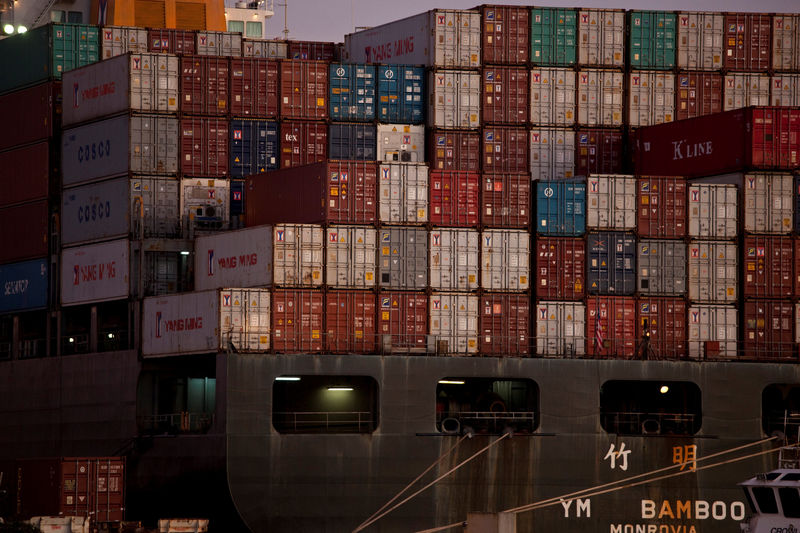By Kevin Yao and Ryan Woo
BEIJING (Reuters) - For China to slash its record trade surplus with the United States by up to $200 billion annually, it would have to buy the equivalent of more than 600 Boeing (N:BA) airliners every year.
U.S. officials said on Thursday that China was offering U.S. President Donald Trump a package of trade concessions and additional purchases of U.S. goods that would cut the U.S. trade deficit with China by as much as $200 billion a year.
But that number would be difficult to hit over several years, let alone one, experts say. It is larger than all of the United States' agricultural and oil exports combined, and would mean selling China nearly nine out of every 10 aircraft Boeing made in 2017.
Talk of the reported offer came on the first of two days of U.S.-China trade talks in Washington focused on resolving tariff threats between the world's two largest economies.
The Chinese foreign ministry has since denied it, saying that China has made no such offer, and that trade negotiations with Washington are still under way.
"Is this a smoke bomb or putting psychological pressure on China?" said Wang Jun, chief economist at Zhongyuan Bank. "This is very inconceivable and very difficult to achieve. The key issue is that they don't want to sell what we want to buy, and we can't buy too many farm products, either."
The scale of change needed to reduce China's trade surplus with the U.S. by $200 billion is staggering, even using the biggest possible mechanisms.
The United States' two largest exports to China by value last year were aircraft, at $16 billion, and soybeans, at $12 billion.
China would have to buy 667 more Boeing commercial jets a year to meet the $200 billion goal, assuming each plane costs $300 million. Boeing made 763 such planes last year.
The U.S. aircraft maker also has a backlog of orders for 5,654 jets, about seven years' worth of manufacturing.
Alternatively, China could buy all of the United States' agricultural exports. But with a value of $138 billion in 2017, those goods would still fall short.
Even selling China all of the United States' oil exports for 2017 would only knock about $8 billion off the U.S. trade deficit at current prices.
Only if the U.S. sold China all, or nearly all, of its yearly oil production would the number reach $200 billion.
It would be painful for China to slash exports to the United States. But if China halted all shipments of its toys, games and sporting goods to the U.S., the trade surplus would only fall by $26.8 billion.
An article carried by the social media account of the overseas edition of the People's Daily, operated by the Communist Party, said the matter was "a misunderstanding purely."
CONCESSIONS STILL EXPECTED
China could make concessions to boost imports from the United States, but it is unlikely to reduce its surplus with the U.S. by up to $200 billion a year, Chinese government advisers said.
"The trade deficit is not a big problem, but it's very difficult to cut it by $200 billion a year," said Liu Xiangdong, a senior economist at China Center for International Economic Exchanges (CCIEE), a Beijing-based think tank.
China can buy more farm products, energy products such as gas and oil, as well as microchips, he said.
The United States had a record trade deficit with China of $375 billion in 2017, according to U.S. data, while Chinese statistics showed a trade surplus of $276 billion - also a historic high.
The discrepancy is caused by different calculation methods and indirect shipments via Hong Kong and other intermediaries.
Xiao Lisheng, a senior economist at the Chinese Academy of Social Sciences (CASS), a top government think tank, said it's more realistic for China to cut the trade surplus by about $30 billion a year, and nearly $100 billion total over three years.
In the first round of trade talks in Beijing this month, top U.S. officials asked China to reduce the trade imbalance by at least $200 billion by 2020.
Trump has threatened to impose up to $150 billion in punitive tariffs to combat what he says is Beijing's misappropriation of U.S. technology through joint venture requirements and other policies.
Beijing has threatened retaliation, including tariffs on some of its largest U.S. imports, including aircraft, soybeans and autos.
Moody's Investors Service said on Monday it does not believe China can meet U.S. demands to cut its trade surplus by $200 billion by 2020 without significant disruptions of its economy.
(For a graphic on 'U.S. trade with China' click https://tmsnrt.rs/2LdzJv4)
